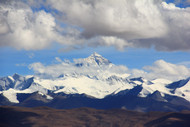Conquering the Impossible: the First Flight Over Everest
By on Apr 5th 2017
Mount Everest
With an elevation of 29,029 ft, Mt. Everest is the highest mountain on planet Earth (from sea level). It has always attracted climbers and mountaineers, and despite time, none of that has changed; Everest has retained its charm. Like a siren, the summit calls out to adventurers looking for a thrill and unique experience.
In 1895, Clint Thomas Dent, an English mountaineer and president of the Alpine Club, suggested the possibility of climbing Mount Everest in his book
Above the Snow Line. Many attempts were made to climb the summit beginning in the 1920s, but the first confirmed successful climb to the summit didn't occur until the ninth expedition in 1953. Led by Colonel John Hunt, Edmund Hillary and Tenzing Norgay reached the summit on Friday, May 29, 1953. The 1924 expedition (the second attempt in history to reach the summit) presents one of the greatest Everest mysteries today. Mountaineers George Mallory and Andrew Irvine disappeared while making their final attempt to the summit; some believe that they might have been successful, but there has been no conclusive evidence to support that theory.
Since the first confirmed expedition to Everest's summit, over 450 people reaching the summit over the course of the past 6 decades. However, Everest was first conquered via air 20 years earlier.
The 5.4979-mile high club
In 1918, a physiologist and mountaineer named Alexander Kellas wrote an article on
The Possibility of Aerial Reconnaissance in the Himalaya. As a skilled mountaineer and expert in physiology, Kellas believed that with the right precautions and the right equipment, given time, they could establish a means to not only fly planes competently at such extreme altitudes but also take useful reconnaissance photographs.
Despite Keller's experience and conviction that Everest's summit could be reached by air, not everyone was convinced-including members of both the Royal Geographical Society and the Alpine Club.
Mountaineer Douglas Freshfield considered Kellas's proposal to be -rank heresy,- and Admiral Mark Kerr-the Deputy-chief of the Air Staff and one of the founders of the Royal Air Force-believed that it would be another century before such a feat could be achieved.
But beliefs change-and technology can prove you wrong. It was only 15 years before an aircraft managed to fly at such an extreme altitude and over the mountain's summit.

Houston Everest Flight of 1933
On April 3, 1933, Lieutenant David McIntyre and Sir Douglas Douglas-Hamilton (better known as Lord Clydesdale) became the first men to fly over the peak of Mount Everest-and prove that Alexander Kellas's beliefs were not the thoughts of a rank heretic, nor 100 years ahead of his time.
Preparations for this historic flight didn't come easy-nor were they necessarily cheap. However, the aerial expedition was made possible with the help of
Lady Houston. Houston-a British philanthropist, political activist, and suffragette known for her glamor as well as her eccentricities-financed the expedition. The flight was organized by Colonel L V Stewart Blacker who served as the chief observer and aerial still photographer. Other members of the Houston Everest Flight of 1933 included lead pilot P.F.M. Fellowes, reserve pilot R.C.W. Ellison and chief cameraman and acting observer S.R. Bonnett.
Prior to WWII, aircraft were incredibly basic, and a lot of care went into choosing an aircraft that could handle the task of flying over the mountain's summit. They needed one built with an engine capacity and propeller that could handle flying to that altitude, and it needed to be equipped with oxygen tanks and mask to combat the issue of thin air.
In November 1932, the team chose two modified Westland Wallace aircraft for the expedition. The two-seat aircraft had open cockpits and were equipped with Bristol Pegasus S3 engines. Lord Clydesdale flew a modified Westland PV-3 accompanied by Colonel Blacker while Lieutenant MacIntyre and Photographer Bonnett followed in a PV-6 model prototype. Both received modifications, including hearing and oxygen equipment. Both aircraft would become the first to fly over Everest.
After preparing for years, success came on April 3, 1933. It was a Monday. With only 15 minutes' worth of fuel and very basic oxygen equipment, Lieutenant David McIntyre and Sir Douglas Douglas-Hamilton managed to pull off a feat that very few had believed possible.
Their successful flight over Everest made the men heroes. Lord Clydesdale was awarded the Air Force Cross and Bonnett's footage was cut into the Academy Award-winning documentary
Wings Over Everest:
Early birds'-eye-view photographs from McIntyre and Hamilton's expedition would provide invaluable photographic and scientific data for visual surveys and measurements of barometric pressure--and later help guide Hillary and Tenzing to the summit.
Sources:
http://www.history.com/news/7-things-you-should-kn...
https://en.wikipedia.org/wiki/Mount_Everest
http://mashable.com/2016/10/01/flying-over-everest...
http://www.scotsman.com/news/remembering-the-scots...
https://www.theguardian.com/theguardian/2013/apr/0...
https://www.avauntmagazine.com/adventure/first-fli...







